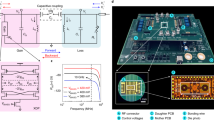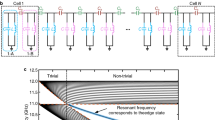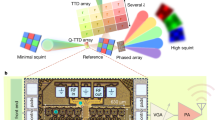Abstract
Floquet topological insulators, which have an exotic topological order sustained by time-varying Hamiltonians, could be of use in a range of technologies, including wireless communications, radar and quantum information processing. However, demonstrations of photonic Floquet topological insulators have been limited to systems that emulate time with a spatial dimension, which preserves time-reversal symmetry and thus removes valuable features including non-reciprocal topological protection. Here we report photonic Floquet topological insulators based on quasi-electrostatic wave propagation in switched-capacitor networks. The approach provides non-reciprocal Floquet topological insulators for electromagnetic waves and opens a large topological bandgap that spans up to gigahertz frequencies. Our devices exploit time modulation to operate beyond the delay–bandwidth limit of conventional linear time-invariant electromagnetic structures and therefore offer large delays, despite the broad bandwidth. The Floquet topological insulator is integrated into a complementary metal–oxide–semiconductor (CMOS) chip, and we illustrate its potential for 5G wireless systems by showing that it can be used for multi-antenna full-duplex wireless operation and true-time-delay-based broadband beamforming.
This is a preview of subscription content, access via your institution
Access options
Access Nature and 54 other Nature Portfolio journals
Get Nature+, our best-value online-access subscription
$29.99 / 30 days
cancel any time
Subscribe to this journal
Receive 12 digital issues and online access to articles
$119.00 per year
only $9.92 per issue
Buy this article
- Purchase on Springer Link
- Instant access to full article PDF
Prices may be subject to local taxes which are calculated during checkout






Similar content being viewed by others
Data availability
The data that support the findings of this study are available from the corresponding authors upon reasonable request.
References
Hasan, M. Z. & Kane, C. L. Colloquium: topological insulators. Rev. Mod. Phys. 82, 3045–3067 (2010).
Moore, J. E. The birth of topological insulators. Nature 464, 194–198 (2010).
Thouless, D. J., Kohmoto, M., Nightingale, M. P. & Dennijs, M. Quantized Hall conductance in a two-dimensional periodic potential. Phys. Rev. Lett. 49, 405–408 (1982).
Kitagawa, T., Berg, E., Rudner, M. & Demler, E. Topological characterization of periodically driven quantum systems. Phys. Rev. B 82, 235114 (2010).
Lindner, N. H., Refael, G. & Galitski, V. Floquet topological insulator in semiconductor quantum wells. Nat. Phys. 7, 490–495 (2011).
Cayssol, J., Dóra, B., Simon, F. & Moessner, R. Floquet topological insulators. Phys. Status Solidi RRL 7, 101–108 (2013).
Rudner, M. S., Lindner, N. H., Berg, E. & Levin, M. Anomalous edge states and the bulk-edge correspondence for periodically driven two-dimensional systems. Phys. Rev. X 3, 031005 (2013).
Haldane, F. D. M. & Raghu, S. Possible realization of directional optical waveguides in photonic crystals with broken time-reversal symmetry. Phys. Rev. Lett. 100, 013904 (2008).
Lu, L., Joannopoulos, J. D. & Soljaclc, M. Topological photonics. Nat. Photon. 8, 821–829 (2014).
Khanikaev, A. B. & Shvets, G. Two-dimensional topological photonics. Nat. Photon. 11, 763–773 (2017).
Ozawa, T. et al. Topological photonics. Rev. Mod. Phys. 91, 015006 (2019).
Albert, V. V., Glazman, L. & Jiang, L. Topological properties of linear circuit lattices. Phys. Rev. Lett. 114, 173902 (2015).
Ningyuan, J., Owens, C., Sommer, A., Schuster, D. & Simon, J. Time- and site-resolved dynamics in a topological circuit. Phys. Rev. X 5, 021031 (2015).
Hofmann, T., Helbig, T., Lee, C. H., Greiter, M. & Thomale, R. Chiral voltage propagation and calibration in a topolectrical Chern circuit. Phys. Rev. Lett. 122, 247702 (2019).
Ni, X., Xiao, Z. C., Khanikaev, A. B. & Alu, A. Robust multiplexing with topolectrical higher-order Chern insulators. Phys. Rev. Appl. 13, 064031 (2020).
Wang, Z., Chong, Y. D., Joannopoulos, J. D. & Soljacic, M. Observation of unidirectional backscattering-immune topological electromagnetic states. Nature 461, 772–775 (2009).
Poo, Y., Wu, R. X., Lin, Z. F., Yang, Y. & Chan, C. T. Experimental realization of self-guiding unidirectional electromagnetic edge states. Phys. Rev. Lett. 106, 093903 (2011).
Chen, W. J. et al. Experimental realization of photonic topological insulator in a uniaxial metacrystal waveguide. Nat. Commun. 5, 5782 (2014).
Cheng, X. J. et al. Robust reconfigurable electromagnetic pathways within a photonic topological insulator. Nat. Mater. 15, 542–548 (2016).
Hafezi, M., Demler, E. A., Lukin, M. D. & Taylor, J. M. Robust optical delay lines with topological protection. Nat. Phys. 7, 907–912 (2011).
Fang, K. J., Yu, Z. F. & Fan, S. H. Realizing effective magnetic field for photons by controlling the phase of dynamic modulation. Nat. Photon. 6, 782–787 (2012).
Rechtsman, M. C. et al. Photonic Floquet topological insulators. Nature 496, 196–200 (2013).
Gorlach, M. A. et al. Far-field probing of leaky topological states in all-dielectric metasurfaces. Nat. Commun. 9, 909 (2018).
Khanikaev, A. B., Fleury, R., Mousavi, S. H. & Alu, A. Topologically robust sound propagation in an angular-momentum-biased graphene-like resonator lattice. Nat. Commun. 6, 8260 (2015).
Fleury, R., Khanikaev, A. B. & Alu, A. Floquet topological insulators for sound. Nat. Commun. 7, 11744 (2016).
Mukherjee, S. et al. Experimental observation of anomalous topological edge modes in a slowly driven photonic lattice. Nat. Commun. 8, 13918 (2017).
Maczewsky, L. et al. Observation of photonic anomalous Floquet topological insulators. Nat. Commun. 8, 13756 (2017).
Tymchenko, M. & Alu, A. Circuit-based magnetless Floquet topological insulator. In 2016 10th International Congress on Advanced Electromagnetic Materials in Microwaves and Optics (METAMATERIALS) 373–375 (IEEE, 2016).
Darabi, A., Ni, X., Leamy, M. & Alu, A. Reconfigurable Floquet elastodynamic topological insulator based on synthetic angular momentum bias. Sci. Adv. 6, eaba8656 (2020).
Peng, Y. G. et al. Experimental demonstration of anomalous Floquet topological insulator for sound. Nat. Commun. 7, 13368 (2016).
Hu, W. et al. Measurement of a topological edge invariant in a microwave network. Phys. Rev. X 5, 011012 (2015).
Gao, F. et al. Probing topological protection using a designer surface plasmon structure. Nat. Commun. 7, 11619 (2016).
Nagulu, A., Tymchenko, M., Alù, A. & Krishnaswamy, H. Ultra compact, ultra wideband, d.c.-1GHz CMOS circulator based on quasi-electrostatic wave propagation in commutated switched capacitor networks. In 2020 IEEE Radio Frequency Integrated Circuits Symposium (RFIC) 55–58 (IEEE, 2020).
Tymchenko, M., Sounas, D., Nagulu, A., Krishnaswamy, H. & Alù, A. Quasielectrostatic wave propagation beyond the delay-bandwidth limit in switched networks. Phys. Rev. X 9, 031015 (2019).
Estep, N. A., Sounas, D. L., Soric, J. & Alu, A. Magnetic-free non-reciprocity and isolation based on parametrically modulated coupled-resonator loops. Nat. Phys. 10, 923–927 (2014).
Reiskarimian, N. & Krishnaswamy, H. Magnetic-free non-reciprocity based on staggered commutation. Nat. Commun. 7, 11217 (2016).
Chalker, J. T. & Coddington, P. D. Percolation, quantum tunnelling and the integer Hall effect. J. Phys. C Solid State Phys. 21, 2665–2679 (1988).
Liang, G. Q. & Chong, Y. D. Optical resonator analog of a two-dimensional topological insulator. Phys. Rev. Lett. 110, 203904 (2013).
Dastjerdi, M. B., Reiskarimian, N., Chen, T., Zussman, G. & Krishnaswamy, H. Full duplex circulator-receiver phased array employing self-interference cancellation via beamforming. In 2018 IEEE Radio Frequency Integrated Circuits Symposium (RFIC) 108–111 (IEEE, 2018).
Dastjerdi, M. B., Jain, S., Reiskarimian, N., Natarajan, A. & Krishnaswamy, H. Analysis and design of a full-duplex two-element MIMO circulator-receiver with high TX power handling exploiting MIMO RF and shared-delay baseband self-interference cancellation. IEEE J. Solid-State Circuits 54, 3525–3540 (2019).
Zhou, J. et al. Integrated full duplex radios. IEEE Commun. Mag. 55, 142–151 (2017).
Katanbaf, M., Chu, K., Zhang, T., Su, C. & Rudell, J. C. Two-way traffic ahead: RF/analog self-interference cancellation techniques and the challenges for future integrated full-duplex transceivers. IEEE Microw. Mag. 20, 22–35 (2019).
Dinc, T. et al. Synchronized conductivity modulation to realize broadband lossless magnetic-free non-reciprocity. Nat. Commun. 8, 795 (2017).
Immoreev, I. & Fedotov, D. V. Ultra wideband radar systems: advantages and disadvantages. In 2002 IEEE Conference on Ultra Wideband Systems and Technologies (IEEE Cat. No. 02EX580) 201–205 (IEEE, 2002).
Roderick, J., Krishnaswamy, H., Newton, K. & Hashemi, H. Silicon-based ultra-wideband beam-forming. IEEE J. Solid-State Circuits 41, 1726–1739 (2006).
Chu, T., Roderick, J. & Hashemi, H. An integrated ultra-wideband timed array receiver in 0.13 μm CMOS using a path-sharing true time delay architecture. IEEE J. Solid-State Circuits 42, 2834–2850 (2007).
Rajesh, N. & Pavan, S. Design of lumped-component programmable delay elements for ultra-wideband beamforming. IEEE J. Solid-State Circuits 49, 1800–1814 (2014).
Mondal, I. & Krishnapura, N. A 2-GHz bandwidth, 0.25–1.7 ns true-time-delay element using a variable-order all-pass filter architecture in 0.13 µm CMOS. IEEE J. Solid-State Circuits 52, 2180–2193 (2017).
Acknowledgements
This work was supported by the DARPA SPAR program (H.K. and A.A.), the AFOSR MURI program (H.K. and A.A.), the Office of Naval Research (A.A.) and the Department of Defense (A.A.). X.N. thanks Y. Peng for the helpful discussion.
Author information
Authors and Affiliations
Contributions
A.N., A.K., A.A. and H.K. initiated the research. A.N. and A.K. simulated and taped out the device. X.N., A.N., A.K. and M.T. conducted the theoretical analysis. A.N. and S.G. conducted the experiments. H.K. and A.A. supervised the research. All the authors wrote the manuscript. A.N., X.N. and A.K. contributed equally to this manuscript.
Corresponding authors
Ethics declarations
Competing interests
The authors declare no competing interests.
Additional information
Publisher’s note Springer Nature remains neutral with regard to jurisdictional claims in published maps and institutional affiliations.
Supplementary information
Supplementary Information
Supplementary Figs. 1–10 and Sections 1–4.
Rights and permissions
About this article
Cite this article
Nagulu, A., Ni, X., Kord, A. et al. Chip-scale Floquet topological insulators for 5G wireless systems. Nat Electron 5, 300–309 (2022). https://doi.org/10.1038/s41928-022-00751-9
Received:
Accepted:
Published:
Issue Date:
DOI: https://doi.org/10.1038/s41928-022-00751-9
This article is cited by
-
Robust boundary-induced bulk propagations in elastic waveguides with nonplanar surfaces
Science China Physics, Mechanics & Astronomy (2024)
-
Experimental demonstration of position-controllable topological interface states in high-frequency Kitaev topological integrated circuits
Communications Physics (2023)
-
Orbital topological edge states and phase transitions in one-dimensional acoustic resonator chains
Nature Communications (2023)
-
Adiabatic topological photonic interfaces
Nature Communications (2023)
-
All-passive microwave-diode nonreciprocal metasurface
Communications Physics (2023)



